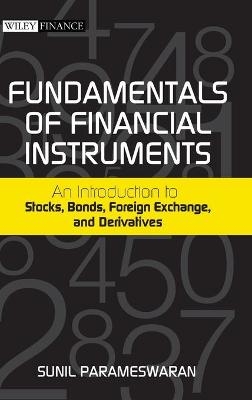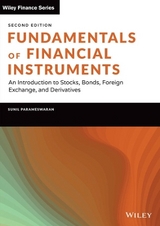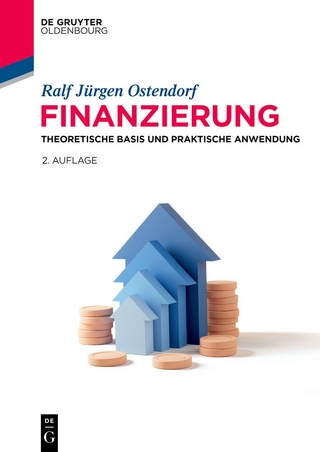
Fundamentals of Financial Instruments
John Wiley & Sons Ltd (Verlag)
978-0-470-82490-0 (ISBN)
The essential guide to financial instruments, logically presented Fundamentals of Financial Instruments deals with the global financial markets and the instruments in which they trade. While most books on finance tend to be heavily mathematical, this book emphasizes the concepts in a logical, sequential fashion, introducing mathematical concepts only at the relevant times. As a result, the reader gains conceptual clarity reinforced by just the right level of technical detail to ensure a comprehensive exposure to the skills needed in the financial world. * Establishes a strong foundation for understanding global markets * Acts as an invaluable resource for those considering a career in the financial markets * Offers an accessible yet in-depth treatise on modern financial instruments * Presents a logical navigational path for a typical student of finance who is attempting to come to terms with the intricacies of the subject Covering the fundamentals of various types of assets in a single volume, Fundamentals of Financial Instruments is a compact yet comprehensive one-stop reference for students and professionals in finance and economics.
Sunil K. Parameswaran is a Professor of Finance at the T.A. Pai Management Institute in Manipal, where he anchors courses in the area of Finance. His primary areas of interest are Securities Markets, Financial Derivatives, Fixed Income Securities, International Finance, and Banking. For the past seven years Dr. Parameswaran has also been a corporate trainer and management consultant. He has delivered training programs on Global Securities Markets and Global Banking to many multinational IT firms located in India including WIPRO Technologies, HCL Technologies, MINDTREE Consulting; JPMorgan Chase, Societe Generale, ANZ Information Technology, and Kanbay (now a part of Cap Gemini). Dr. Parameswaran also has several years of teaching experience at leading business schools in the U.S., Singapore, Australia, and India. Dr. Parameswaran obtained his Ph.D. in Finance from the Fuqua School of Business at Duke University in North Carolina, U.S.A. He obtained his M.B.A. from the Indian Institute of Management, Bangalore. A prolific writer, he has published several books, primarily in the field of Financial Derivatives.
Preface xiii Acknowledgments xv Chapter 1 An Introduction to Financial Institutions, Instruments, and Markets 1 The Role of an Economic System 1 A Command Economy 2 A Market Economy 3 Classification of Economic Units 4 An Economy s Relationship with the External World 7 The Balance of Trade 9 The Current Account Balance 9 Financial Assets 10 Primary Markets and Secondary Markets 22 Exchanges and OTC Markets 24 Brokers and Dealers 27 The Need for Brokers and Dealers 29 Trading Positions 31 The Buy Side and the Sell Side 31 Investment Bankers 32 Direct and Indirect Markets 33 Mutual Funds 36 Money and Capital Markets 40 The Eurocurrency Market 41 The International Bond Market 43 Globalization of Equity Markets 45 Dual Listing 46 Fungibility 49 Risk 51 After the Trade: Clearing and Settlement 54 Dematerialization and the Role of a Depository 54 Custodial Services 55 Globalization: The New Mantra 56 Chapter 2 Mathematics of Finance 59 Interest Rates 59 The Real Rate of Interest 60 The Fisher Equation 60 Simple Interest 64 Compound Interest 66 Properties 68 A Symbolic Derivation 71 Principle of Equivalency 72 Continuous Compounding 73 Future Value 74 Present Value 76 Handling a Series of Cash Flows 77 The Internal Rate of Return 79 Evaluating an Investment 79 Annuities: An Introduction 82 Perpetuities 87 The Amortization Method 88 Amortization with a Balloon Payment 91 The Equal Principal Repayment Approach 92 Types of Interest Computation 93 Loans with a Compensating Balance 94 Chapter 3 Equity Shares, Preferred Shares, and Stock Market Indexes 97 Introduction 97 Par Value versus Book Value 99 Voting Rights 100 Statutory versus Cumulative Voting 101 Proxies 101 Dividends 102 Dividend Yield 104 Dividend Reinvestment Plans 105 Stock Dividends 106 Treasury Stock 107 Splits and Reverse Splits 108 Costs Associated with Splits and Stock Dividends 110 Preemptive Rights 110 Interpreting Stated Ratios 113 Handling Fractions 113 Physical Certificates versus Book Entry 114 Tracking Stock 115 Report Cards 115 Types of Stocks 115 Risk and Return and the Concept of Diversification 116 Preferred Shares 119 Callable Preferred Stock 120 Convertible Preferred Shares 121 Cumulative Preferred Shares 122 Adjustable Rate Preferred Shares 124 Participating Preferred Shares 125 Dividend Discount Models 125 A General Valuation Model 125 The Constant Growth Model 126 The Two-Stage Model 127 The Three-Stage Model 128 The H Model 130 Stock Market Indexes 131 Price-Weighted Indexes 131 Changing the Divisor 133 The Importance of Price 135 Value-Weighted Indexes 136 Changing the Base-Period Capitalization 139 Equally Weighted Indexes 140 Tracking Portfolios 141 The Free-Floating Methodology 149 Well-Known Global Indexes 150 Margin Trading and Short Selling 150 Terminology 150 Maintenance Margin 156 Regulation T and NYSE and NASD Rules 157 Short Selling 157 Chapter 4 Bonds 167 Valuation of a Bond 170 Par, Premium, and Discount Bonds 172 Evolution of the Price 173 Zero-Coupon Bonds 175 Valuing a Bond in between Coupon Dates 176 Day-Count Conventions 177 ActualActual 177 The Treasury s Approach 179 Corporate Bonds 180 Accrued Interest 181 Yields 183 Taxable-Equivalent Yield 192 Credit Risk 194 Bond Insurance 195 Equivalence with Zero-Coupon Bonds 195 The Yield Curve and the Term Structure 199 Bonds with Embedded Options 206 Price Volatility 211 Duration and Price Volatility 214 Dollar Duration 215 Convexity 215 Treasury Auctions 219 When Issued Trading 223 Price Quotes 223 Bond Futures 224 STRIPS 225 Chapter 5 Money Markets 227 Introduction 227 Market Supervision 231 The Interbank Market 234 Interest-Computation Methods 238 Term Money Market Deposits 240 Federal Funds 240 Correspondent Banks: Nostro and Vostro Accounts 242 Payment Systems 243 Fed Funds and Reserve Maintenance 244 Treasury Bills 245 Yields on Discount Securities 246 Discount Rates and T-Bill Prices 247 Primary Dealers and Open-Market Operations 257 Commercial Paper 271 Letters of Credit and Bank Guarantees 272 Yankee Paper 274 Credit Rating 275 Bills of Exchange 277 Eurocurrency Deposits 280 Money Market Futures 282 Chapter 6 Forward and Futures Contracts 283 Introduction 283 SpotFutures Equivalence 296 Cash-and-Carry Arbitrage 299 Synthetic Securities 300 The Case of Assets Making Payouts 301 Physical Assets 303 The Case of Multiple Deliverable Grades 307 Trading Volume and Open Interest 314 Cash Settlement 316 Hedging and Speculation 317 Estimation of the Hedge Ratio and the Hedging Effectiveness 321 Speculation 322 Leverage 325 Contract Value 325 Forward versus Futures Prices 327 Locking in Borrowing and Lending Rates 327 Hedging the Rate of Return on a Stock Portfolio 329 Changing the Beta 331 Program Trading 332 Stock Picking 336 Portfolio Insurance 338 The Importance of Futures 340 Chapter 7 Options Contracts 343 Moneyness 349 Exchange-Traded Options 350 Speculation with Options 369 The Two-Period Model 378 Valuation of European Put Options 381 Valuing American Options 382 Implementing the Binomial Model in Practice 383 The Black-Scholes Model 384 The Greeks 387 Option Strategies 388 Chapter 8 Foreign Exchange 405 Introduction 405 Currency Codes 406 European Terms and American Terms 408 Appreciating and Depreciating Currencies 409 Converting Direct Quotes to Indirect Quotes 410 The Impact of Spreads on Returns 412 Arbitrage in Spot Markets 413 Cross Rates 417 Value Dates 418 The Forward Market 419 Outright Forward Rates 420 Swap Points 420 Broken-Dated Contracts 422 A Perfect Market 424 The Cost 426 Interpretation of the Swap Points 430 Short-Date Contracts 431 Option Forwards 434 Nondeliverable Forwards 438 Futures Markets 438 Hedging Using Currency Futures 441 Exchange-Traded Foreign Currency Options 444 The Garman-Kohlhagen Model 446 Put-Call Parity 448 The Binomial Model 448 Chapter 9 Mortgages and Mortgage-Backed Securities 451 Introduction 451 Market Participants 451 Government Insurance and Private Mortgage Insurance 454 Risks in Mortgage Lending 455 Other Mortgage Structures 457 Negative Amortization 463 Graduated-Payment Mortgage 465 WAC and WAM 467 Pass-Through Securities 468 Extension Risk and Contraction Risk 492 Accrual Bonds 492 Floating-Rate Tranches 497 Notional Interest Only Tranche 498 Interest-Only and Principal-Only Strips 500 PAC Bonds 500 Agency Pass-Throughs 506 Chapter 10 Swaps 509 Introduction 509 Contract Terms 512 Market Terminology 514 Inherent Risk 515 The Swap Rate 515 Illustrative Swap Rates 515 Determining the Swap Rate 516 The Market Method 518 Valuation of a Swap During Its Life 519 Terminating a Swap 520 The Role of Banks in the Swap Market 521 Comparative Advantage and Credit Arbitrage 523 Swap Quotations 524 Matched Payments 525 Currency Swaps 526 Cross-Currency Swaps 528 Currency Risks 530 Hedging with Currency Swaps 530 Appendix 1 533 Appendix 2 535 Bibliography 537 Web Sites 541 Index 543
| Erscheint lt. Verlag | 3.11.2011 |
|---|---|
| Verlagsort | Chichester |
| Sprache | englisch |
| Maße | 149 x 245 mm |
| Gewicht | 900 g |
| Themenwelt | Wirtschaft ► Betriebswirtschaft / Management ► Finanzierung |
| ISBN-10 | 0-470-82490-5 / 0470824905 |
| ISBN-13 | 978-0-470-82490-0 / 9780470824900 |
| Zustand | Neuware |
| Haben Sie eine Frage zum Produkt? |
aus dem Bereich



